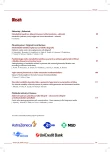The diurnal variability of blood pressure in patients with hypertension and rheumatoid arthritis
Authors:
I. Řiháček; P. Fráňa; M. Souček; M. Plachý; Bohuslav Kianička
Authors‘ workplace:
II. interní klinika Lékařské fakulty MU a FN u sv. Anny Brno, přednosta prof. MUDr. Miroslav Souček, CSc.
Published in:
Vnitř Lék 2009; 55(2): 111-116
Category:
Original Contributions
Overview
Background:
The patients with rheumatoid arthritis have high prevalence of hypertension and increased risk of cardiovascular morbidity and mortality.
Objective:
To determine the level of clinical blood pressure (BP) and 24h ambulatory BP in patients with rheumatoid arthritis and hypertension. Analyze the diurnal variability of BP depending on chronic treatment with prednisone, nonsteroidal anti‑inflammatory drugs and methotrexate. Group of patients: 60 patients with clinically stable rheumatoid arthritis and treated or newly diagnosed hypertension. 15 male and 45 female, mean age 58 ± 11.3 years.
Results:
Mean clinical systolic BP 139.0 ± 14.7 mm Hg, diastolic BP 85.7 ± 6.5 mm Hg and heart rate 74.9 ± 7.3 beat.min–1. Mean 24h systolic BP 127.7 ± 12.6 mm Hg, diastolic BP 77.7 ± 7.4 mm Hg and heart rate 73.9 ± 8.7 beat.min–1. Mean clinical pulse pressure 54.7 ± 15.6 mm Hg, mean 24h pulse pressure 50.1 ± 11.6 mm Hg. In the whole group of patients the number of systolic dippers was 28 (47%), nondippers 17 (28%), excesive dippers 11 (18%) and risers 4 (7%), diastolic dippers 27 (45%), nondippers 9 (15%), excesive dippers 22 (37%) and risers 2 (3%). The patients treated with prednisone and nonsteroidal anti‑inflammatory drugs were nondippers in 34% both for systolic BP, in 19% and 20% respectively for diastolic BP. They were excessive dippers for systolic BP in 22% and 20% respectively, for diastolic BP in 37% and 38% respectively. In the course of the treatment with methotrexate were 22% patients nondippers for systolic BP and 8% for diastolic BP, 28% was excessive dippers for systolic BP, 47% for diastolic BP.
Conclusion:
Patients with rheumatoid arthritis and hypertension have a slightly increased pulse pressure (55 mm Hg for clinical BP and 50 mm Hg for 24h ambulatory BP) in comparison to arbitrary limits in generally population. Patients treated with prednison and nonsteroidal anti‑inflammatory drugs were more often nondippers (34%) in systolic BP than hypertensive control. The patients treated with methotrexate (47%), prednisone (37%) and nonsteroidal anti‑inflammatory drugs (38%) were more often excessive dippers in diastolic BP than hypertensive control.
Key words:
hypertension – rheumatoid arthritis – 24h ambulatory blood pressure monitoring – diurnal variability of blood pressure – cardiovascular risk
Sources
1. Kaplan MJ. Cardiovascular disease in rheumatoid arthritis. Curr Opion Rheumatol 2006; 18: 289–297.
2. Widimský J, Cífková R, Špinar J et al. Doporučení diagnostických a léčebných postupů u arteriální hypertenze – verze 2007. Doporučení České společnosti pro hypertenzi. Vnitř Lék 2008; 54: 101–118.
3. Panoulas VF, Douglas KM, Milionis HJ et al. Prevalence and associations of hypertension and its control in patients with rheumatoid arthritis. Rheumatology (Oxford) 2007; 46: 1477–1482.
4. Trnavský K. Léčebná péče v revmatologii. Praha: Grada-Avicenum 1993.
5. 41st World Medical Assembly. Declaration of Helsinki: recommendations guiding physicians in biomedical research involving human subjects. Bull Pan Am Health Organ 1990; 24: 606–609.
6. Nemec P, Pavkova-Goldbergova M, Gatterova J et al. Association of the 5A/6A promoter polymorphism of the MMP-3 gene with the radiographic progression of rheumatoid arthritis. Ann NY Acad Sci 2007; 1110: 166–176.
7. Nemec P, Pavkova-Goldbergova M, Stouracova M et al. Polymorphism in the tumor necrosis factor‑alpha gene promoter is associated with severity of rheumatoid arthritis in the Czech population. Clin Rheumatol 2008; 27: 59–65.
8. Widimský J a kol. Hypertenze. Praha: Triton 2008.
9. Hamada T, Murata T, Narita K et al. The clinical significance of abnormal diurnal blood pressure variation in healthy late middle-aged and older adults. Blood Press 2008; 17: 134–140.
10. Pierdomenico SD, Lapenna D, Bucci A et al. Cardiovascular outcome in treated hypertensive patients with responder, masked, false resistant and true resistant hypertension. Am J Hypertens 2005; 18: 1422–1428.
11. Peixoto AJ, White WB. Circadian blood pressure: clinical implications based on the pathophysiology of its variability. Kidney Int 2007; 71: 855–860.
12. Staessen JA, Bieniaszewski L, O’Brien E et al. Nocturnal blood pressure fall on ambulatory monitoring in a large international database. The “Ad Hoc” Working Group. Hypertension 1997; 29: 30–39.
13. Cuspidi C, Meani S, Salerno M et al. Reproducibility of nocturnal blood pressure fall in early phases of untreated essential hypertension: a prospective observational study. J Hum Hypertens 2004; 18: 503–509.
14. Morrison A, Ramey DR, van Adelsberg J et al. Systematic review of trials of the effect of continued use of oral non‑selective NSAIDs on blood pressure and hypertension. Curr Med Res Opin 2007; 23: 2395–2404.
15. Bečvář R, Vencovský J, Němec P et al. Doporučení České revmatologické společnosti pro léčbu revmatoidní artritidy. Účinnost a strategie léčby. Vnitř Lék 2008; 54: 84–99.
Labels
Diabetology Endocrinology Internal medicineArticle was published in
Internal Medicine

2009 Issue 2
Most read in this issue
- Superficial thrombophlebitis – diagnostics and treatment
- Guidelines for duplex ultrasound exam of limb veins
- Aortic valve sparing operations and reconstruction – from anatomy to the long‑term results
- The combination of an ACE inhibitor and a calcium channel blocker is an optimal combination for the treatment of hypertension
